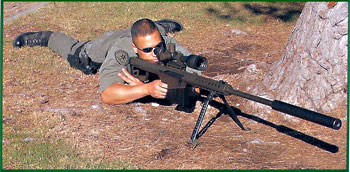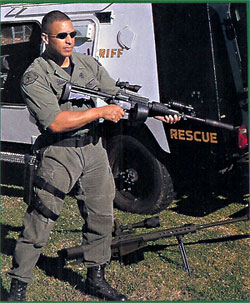
| Copyright © Eugene Nielsen | ||
by Eugene Nielson
Sound-suppressed weapons are seeing increased use among today's law enforcement tactical teams. Some in the general public may question why a law enforcement agency needs sound-suppressed weapons. This is understandable, given the widespread misconceptions that are held about the true role of silencers. Hopefully, this article will dispel the misconceptions that are commonly held about firearm sound suppressors and give the reader a better understanding of the history, technology and tactical applications of these devices.
Sound suppressors are valuable tools that can save lives. They have a definite role to play in law enforcement. Fortunately, law enforcement agencies are beginning to recognize the value of using suppressed weapons during tactical operations.
Tactical Role
There are many reasons why a tactical team may employ sound suppressors. One
reason for their use during tactical operations is their effectiveness in terms
of command and control. The use of suppressed weapons helps ensure that operators
will be able to hear voice commands. Operators won't be temporarily deafened
or disoriented by the discharge of their weapons in close quarters, as they
could be if nonsuppressed weapons were employed and hearing protection wasn't
being worn. If the weapons of all team members are equipped with suppressed
weapons, hostile fire can be more easily pinpointed and eliminated. Sound suppressors
also give tactical operators the capability to covertly disable or take out
selected targets, such as vehicles, lights or guard dogs, in situations where
this becomes a tactical necessity.
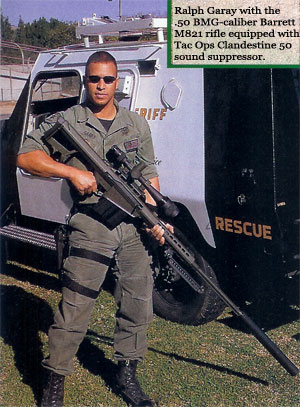 The use of a suppressor eliminates any muzzle flash and sound
signature that can identify the shooter's position or disturb vision and hearing.
The lack of a muzzle-flash signature isn't only important in night operations.
It can also be absolutely essential when operating in a potentially explosive
environment, such as when raiding clandestine drug laboratories.
The use of a suppressor eliminates any muzzle flash and sound
signature that can identify the shooter's position or disturb vision and hearing.
The lack of a muzzle-flash signature isn't only important in night operations.
It can also be absolutely essential when operating in a potentially explosive
environment, such as when raiding clandestine drug laboratories.
The suppressor greatly reduces any ground disturbance when firing from a
prone position. Many shooters find that their accuracy improves when a suppressor
is employed, due to the resulting reduction in the muzzle blast and recoil.
The reduction in recoil also permits quicker follow-up shots.
A sound suppressor can substantially reduce the recoil velocity and recoil energy of a firearm. Gas volume and gas pressure at the muzzle are major factors in the free recoil energy produced by a firearm. All other factors being equal, increased gas volumes and higher gas pressures at the muzzle will increase the recoil velocity and free recoil energy.
Free recoil energy is proportional to the square of the recoil velocity of the firearm. Doubling the recoil velocity quadruples the free recoil energy. Sound suppressors reduce the free recoil energy by suppressing the effects of the expanding powder gasses. They also add weight, slowing the acceleration of the weapon.
|
Ralph
Garay of the Los Angeles County Sheriff's Department Special Enforcement
Bureau Special Weapons Team with .50 BMG-caliber Barrett M82A1 rifle
equipped with Tac Ops Clandestine 50 sound suppressor. The sound
signature of the Clandestine 50 has been likened to a sneeze. The
Clandestine 50 also greatly reduces recoil and eliminates muzzle
blast/flash. Note that the weapon has been finished in Walter Birdsong's
Green-T and Black-T. |
HISTORY
The first practical sound suppressor for firearms was designed in 1908 by American
inventor and manufacturer Hiram P. Maxim, son of Hiram S. Maxim. The elder
Maxim was best known for his development of the Maxim machine gun.
Maxim didn't set out to develop a sound suppressor for firearms. The Maxim silencer was a result of the younger Maxim's efforts to improve the gasoline-powered automobile. His research on the exhaust muffler led to the invention of his now-famous device. Although no sound suppressor completely silences a firearm, those who quibble over the use of the word silencer should take note of the fact that Maxim himself called his device a silencer.
Maxim's invention brought him both fame and notoriety. During World War I, the Maxim silencer was used by the u.s. Army to a limited extent on the 1903 Springfield rifle. Although the Maxim silencer never saw widespread use, public furor led to its prohibition in many states and in several foreign countries. As a result, Maxim stopped its manufacture in 1930. Federal restrictions were imposed with the passage of the National Firearms Act (NFA) of 1934.
The arrival of World War II led to renewed interest in sound suppressors by the military. A new generation of more effective suppressed weapons was developed. During the war, the M3, M3Al and the Sten SMGs were the principal Allied weapons that were equipped with suppressors. Personnel with the U.S. Office of Strategic Services (OSS) and British Special Operations Executive (SOE) were also issued the Mk I Hand Firing Device (also known as the Welrod), the DeLisle Carbine and the Sleeve Gun. Suppressed High Standard HD pistols were also issued. From the end of World War I until the Vietnam War, there were very few advancements in suppressor design. This all changed in the 1960s with the development of the Sionics sound suppressor, designed by the late Mitchell WerBell III, head of the now defunct Military Armaments Corporation, and firearms designer Gordon Ingram, perhaps best known for his design of the MI0 ("MAC 10") and Mll SMGs. Among the innovations of the Sionics suppressor was the addition of a gas-pressure relief valve. This was necessary to hold the cyclic rate of gas operated weapons down when a sound suppressor was employed. Without gas-pressure relief, gasses can also be forced back through the weapon's chamber, resulting in significant sound pressure (noise). WerBell did much to legitimize the use
of sound suppressors. This has resulted in increased research and development.
Today's state-of-the-art suppressors are smaller, more effective and
have a much greater operational life than their predecessors. Some of
today's better suppressors, when properly maintained, will actually outlast
the barrel to which they're attached. |
|
The Nature of Sound The specification of the intensity of the sound, as ordinarily used, implies a comparison with the smallest level of sound detectable by the human ear. The smallest level of sound that can be detected by the human ear is around one dB (0.1 bel). Normal conversation is around 60 dB. The average threshold of pain for the human ear is around 130 dB. Hearing damage as the result of short-duration exposure to loud noise begins around 140 dB. There are two types of noise that can damage hearing-short-duration, high-intensity noise, such as gunshots, and prolonged exposure to lower levels of noise. Although individual sensitivity varies, many authorities believe that prolonged exposure to noise above 85 dB can lead to hearing damage. How Suppressors Work |
|
The muzzle blast is the most significant source of sound that's generated by a firearm. A .22 LR handgun generates around 148 dB. A 9mm MP5 SMG generates around 157 dB. An M16 generates around 168 dB. Again, when comparing dB, always keep in mind the logarithmic relationship of a dB. Also keep in mind that the dB output can fluctuate by several dB due to differences in atmospheric conditions, i.e., temperature, humidity and atmospheric pressure.
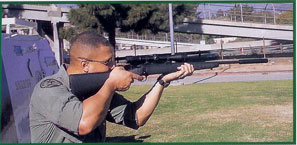 Ralph Garay with customized Ruger 77/22 rifle equipped Tac Ops 22 external, screw-on sound suppressor. |
Muzzle blast is the consequence of the shock waves resulting from high-pressure gases exiting the barrel. If the pressure is reduced immediately before it exits, the weapon's report will be reduced. Hollywood movies aside, conventional revolvers can't be effectively suppressed due to the gap between the cylinder and the forcing cone. To effectively suppress a revolver, it's necessary to eliminate the gap. Shotguns have also proved problematic. There have been numerous attempts to silence shotguns and eliminate their muzzle flash. The large-bore diameter of the 12-gauge shotgun has been the major impediment to the development of an effective sound suppressor. Conventional sound-suppressor designs of a practical size have allowed too much gas to escape to effectively silence the weapon. |
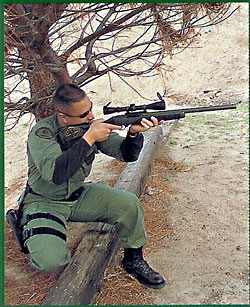 Ralph Garay with Tac Ops Green Hornet, a Ruger 10/22 with integral sound suppressor. The appearance of the suppressor closely resembles a standard bull barrel. |
The only practical sound suppressor for shotguns to date is manufactured by Tactical Operations Inc. of Beverly Hills, California. Called the Clandestine 12, the sound suppressor, which was reviewed in the September 2000 issue of S.W.A.T., utilizes an advanced, patent-pending design with proprietary artificial-environment technology. Pressure can be reduced by increasing the volume of space occupied by a given quantity of gasses and/ or decreasing the temperature of the gasses. To understand why this is the case, a basic understanding of the laws of physics is necessary. All sound suppressors make use of a theory known as the General Gas Law, which is derived from the kinetic theory of gasses. The General Gas Law is an idealized relation between pressure, volume and temperature that is applicable to ideal gasses. The General Gas Law states that for a specified quantity of gas, the product of the volume (v) and pressure (p) is proportional to the absolute temperature (t). This may be represented by the equation pv = kt, in which k is a constant. Muzzle blast is also reduced by .decreasing velocity of the gases and either absorbing the sound waves or canceling them by interference with reflected waves coming from the same source. Sound waves behave in many ways similar to light waves. As with light waves, sound waves can be reflected, refracted, diffracted and scattered. |
Various combinations of components, such as baffles, spacers, packing material, mesh, expansion chambers, spiral diffusers, pressure relief ports and wipes, may be employed in a suppressor to "silence" a firearm. A relatively recent innovation is the use of artificial-environment technology, which use greases, oils or other fluids that cool the gasses for more effective sound suppression. Additionally, the use of artificial environment technology provides an increase in the efficiency-to-size ratio of the suppressor.
Wet technology is a common artificial environment that's being utilized for suppressors. Besides providing additional sound suppression by adding a small amount of water or light oil, many wet technology sound suppressors can be fired full of water without damage.
Lithium grease is another common artificial environment for suppressors. While the use of lithium grease allows suppressors to be very small and still be effective, it results in a higher maintenance requirement. The lithium grease will need to be frequently recharged. Recharging will typically need to be done after a couple of magazines have been fired.
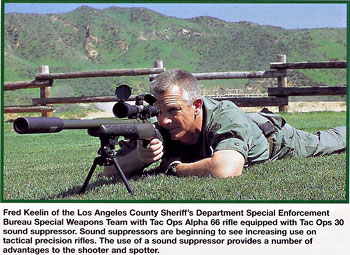 As
a suppressor accumulates fouling during firing, its effectiveness will deteriorate.
The maintenance requirements will differ depending on the suppressor. Some
baffled systems require nothing more than dunking in solvent to clean out the
fouling. Other designs may require repacking or the replacement of "wipes" at
the factory. It should be noted that silencer parts fall under provisions
of the NFA.
As
a suppressor accumulates fouling during firing, its effectiveness will deteriorate.
The maintenance requirements will differ depending on the suppressor. Some
baffled systems require nothing more than dunking in solvent to clean out the
fouling. Other designs may require repacking or the replacement of "wipes" at
the factory. It should be noted that silencer parts fall under provisions
of the NFA.
A sonic "crack" will be produced downrange from the weapon if a projectile's velocity exceeds the speed of sound-about 1,087 feet per second (fps) at 32° F in still, dry air at a sea level pressure of 14.7 pounds per square inch, based on a 1987 calculation. This miniature sonic boom mayor may not be of consequence, depending on the mission requirements in which suppressed weapons will be employed. It should be noted that it is not possible to pinpoint the source of fire solely by using the crack created by the passing of a supersonic bullet.
Two methods may be employed to eliminate the sonic crack: the use of subsonic ammunition; or reducing the velocity of a bullet to subsonic by venting the gasses propelling the bullet via ports drilled into the barrel. Suppressed weapons with ported barrels utilize an integral suppressor.
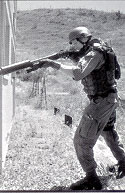 Weapons with ported barrels and integral sound suppressors,
such as the HK MP5SD, FAMAE SAF Silenced S1 and Sterling L34A1 SMGs, do not
require the use of subsonic ammunition for effective sound reduction. They're
designed for specialized applications that require fully realized sound and
flash suppression. Because the suppressor is integral to the weapon, the weapon
may not be used in a nonsuppressed mode.
Weapons with ported barrels and integral sound suppressors,
such as the HK MP5SD, FAMAE SAF Silenced S1 and Sterling L34A1 SMGs, do not
require the use of subsonic ammunition for effective sound reduction. They're
designed for specialized applications that require fully realized sound and
flash suppression. Because the suppressor is integral to the weapon, the weapon
may not be used in a nonsuppressed mode.
Muzzle sound suppressors are more versatile than integral suppressors,
in that they can easily be removed when sound suppression is not necessary.
If subsonic ammunition is employed, muzzle suppressors are often every bit
as quiet as an integral suppressor. Because they do not reduce the velocity
of a bullet, higher terminal velocities are possible for applications in which
a sonic crack is not an important tactical consideration.
(left: Bruce Chase of the Los Angeles County Sheriff's
Department Special Enforcement Bureau Special Weapons Team with Tac Ops Clandestine
12 sound-suppressed shotgun. Photo by Stan Nielsen.
)
Although generally of little tactical consequence, if absolute sound suppression is necessary, a single shot or manually operated action will also be necessary. Early examples include the World War II era Mk I Hand Firing Device, DeLisle Carbine and the Sleeve Gun, which had silenced mechanisms.
It is interesting to note that, although we have come a long way in suppressor design, the Mk I Hand Firing Device (.45 ACP) is still the standard by which modern suppressors are compared. During testing conducted by the U.S. Army's Foreign Science and Technology Center (FSTC), the World War II vintage weapon test fired at an average sound level of 117.4 dB.
If semiautomatic or fully automatic firearms are employed, there will be noise from the action cycling unless some provision is made to prevent the action from cycling. Examples of pistols with this provision include the Smith & Wesson Mk 22 Mod 0 pistol, nicknamed the Hush-Puppy, developed for U.s. Navy SEAL Teams during the Vietnam conflict, and the Soviet/Russian Makarov P6. Although a slide lock was originally specified for the new .45 ACP HK Mk 23 USSOCOM pistol, developed for U.s. Special Operations forces, that requirement was dropped prior to production.
The semiautomatic functioning of pistols with Browning-type tilting barrel unlocking systems, such as Glock, SIG, Browning P35, M1911, Smith & Wesson and Walther P88 and P99 pistols, may be impaired by the weight of the suppressor on the barrel. To overcome this problem, lighter weight suppressors or recoil enhancing accessories may be employed. Lightweight, artificial environment suppressors are preferable for this type of weapon.
Tactical Operations' new Special Purpose 9 (SP9) sound suppressor is an excellent example of a lightweight, compact suppressor for 9mm pistols that allows reliable functioning of Browning-design-type pistols, as well as use of the pistol's standard sights. The SP9 utilizes a state-of-the-art baffling system and artificial environment (lithium grease) for maximum performance. The SP9 provides outstanding performance and complete suppression of the muzzle flash signature.
Selection
When selecting a sound suppressor/weapon system, a variety of factors need
to be taken into consideration. These include the operational requirements
in the mission in which it will be employed, any special ammunition requirements,
cost and any required modification to the weapon.
Any comparisons between suppressors need to be carefully considered, since the method of testing that's utilized by manufacturers may vary from manufacturer to manufacturer, making comparisons difficult, unless one has the details as to how the testing was conducted. u.s. military requirements for testing are specified in MIL-STD-1474C.
While silencers may have an image problem in the eyes of the general public
and some police administrators, they are, nevertheless, valuable tools
in the arsenal of today's law enforcement tactical teams and military special-operations
units. Their true role is far removed from that of the sinister devices
portrayed in the popular media.
Tactical
Operations, Inc.
433 North Camden Dr. 4th
Fl. #239
Beverly Hills, Ca 90210
Phone 310 275-8797
Fax 323 933-3521
Email: blackops2@earthlink.net


